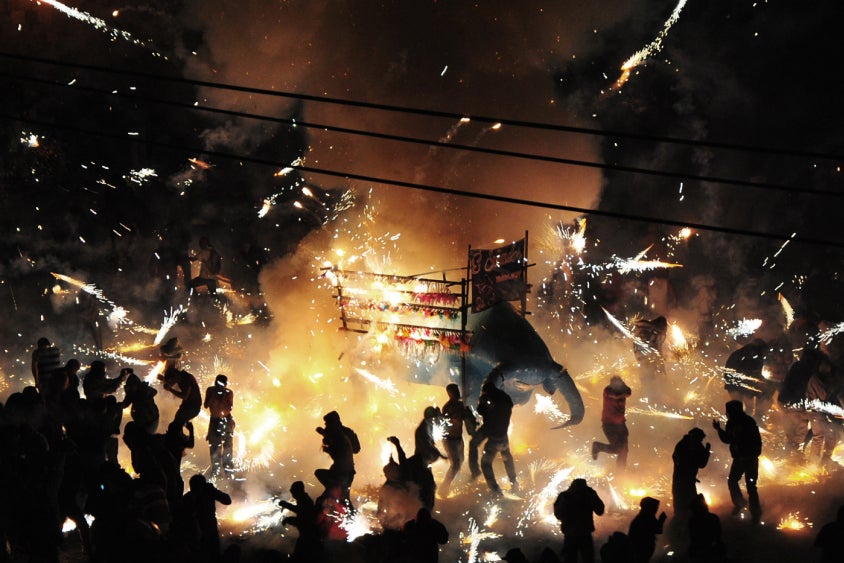The not-so-secret secret of the Fourth of July is that fireworks are boring. You drag a towel out onto a lawn or schelp onto a bridge, and after a couple hours of stewing in your own sweat, you’re rewarded with a shower of far-off sparks and some snap-crackle-pop, a tepid spectacle that is to genuine amazement what a CBS sitcom is to laughter: It has the shape of the thing but not the substance.
The good news is it doesn’t have to be that way. The bad news is that in order to make fireworks exciting, you have to risk getting burned. In Viktor Jakovelski’s documentary Brimstone & Glory, which airs tonight on PBS and will be streaming online for free beginning tomorrow, the sparks don’t fly so much as drift, their progress retarded by slow motion as they burn incandescent arcs in the air. And as they do, the men and boys of the northern Mexican town of Tultepec seem to weave their way between them, their bodies and faces barely protected by hooded sweatshirts as they dance around the fire.
A product of Court 13 Pictures, best known for Beasts of the Southern Wild, Brimstone & Glory has some of that movie’s dreamy draftiness, but without its political ick. Tultepec’s annual 10-day pyrotechnic festival isn’t just a celebration of San Juan de Dios, the patron saint of fireworks-makers, but an advertisement for the town’s main industry. Tultepec’s fireworks aren’t made in factories but by hand, or sometimes by stump, since adding the right amount of explosive to ensure a sufficiently impressive bang can be a dangerous, even fatal, pursuit.
Jakovelski sticks GoPro cameras on the heads of men who climb tall wooden towers to make “castles of fire,” the view from the tops of which is enough to give you vertigo. (I first saw the film, in its uncut 67-minute glory, at the True/False Film Festival, where the big screen made it feel as if you might plummet to earth at any minute; the version shown on PBS will be both smaller and shorter by some 15 minutes, although the original is available on iTunes and elsewhere.) And he at least seems to follow the young men who, at the festival’s peak, dance around the “bulls,” creatures made of wood and wire that somehow house pyrotechnics without catching on fire themselves themselves.
There are plenty of injuries, tended to by experienced, sometimes jaded-sounded paramedics who push the rowdiest revelers to the back. Given the futures that await many of them, you can’t blame the young men for risking their bodies just for the thrill. “When the moment comes, it’s just the bull and you,” one reflects. “You forget about everything. It’s just seconds, minutes. But when the burning stars, you feel like it’s an eternity.”
Given the price the residents of Tultepec pay, perhaps we should cherish our safely distant displays, assembled by invisible hands and triggered by professionals adept in the art of making them just interesting enough. What a luxury it is to be bored.
